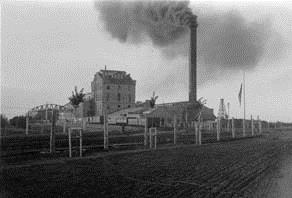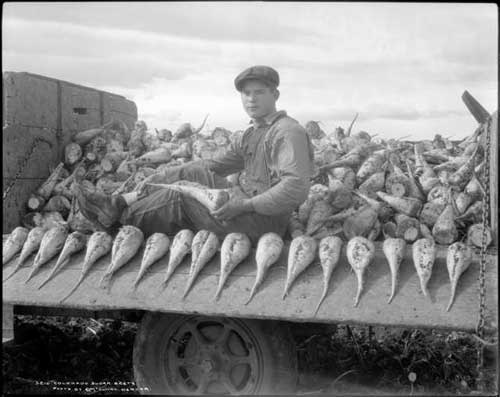Each fall as we drive north and east of Fort Collins we all experience the same thing, trying not to hit tuberous vegetables with our cars. While some may see them as a danger others are aware of the vast influence sugar beets have had on the growth and culture of Fort Collins.
Sugar beets were introduced near Littleton Colorado in the 1860’s and slowly spread throughout the state. In 1901 the Great Western Sugar Company built a sugar beet processing factory in Loveland, which ramped up local production. Fort Collins received its own factory in 1903. With increased employment because of the new factory the population of Fort Collins boomed in the first decade of the 20th century. This population boom even lead to the establishment of the Carnegie Library in 1904. Specific classes were offered at CU on how to process beet sugar. WWI increased the cost of sugar and farmer’s profits grew from $5.25 per ton to $5.75 per ton.
The sugar industry also brought in the Germans from Russia who comprise one of the largest ethnic groups in Colorado. The first laborers arrived to work in the sugar beet fields near Brighton in 1886. The history of their immigration and preservation of their Germanic heritage in our community is fascinating.

During the 1930’s due to the depression the price of sugar beets dropped drastically and many small farmers were left with nothing.
In 1974 the Great Western Sugar Company was sold and due to added competition with cane sugar from overseas the price of sugar dropped, causing the sugar beet industry in Colorado to slow down.
So this fall, as you avoid those tuberous vegetables on the roadway, remember the influence they have had on our community. You may want to stop and pick one up for your kids show and tell!
Resources
http://history.poudrelibraries.org/archive/contexts/sugar.php
http://history.poudrelibraries.org/archive/contexts/post.php
Akron Weekly Pioneer Press. January 15,1904. Pg.4
Akron Weekly Pioneer Press. October 2, 1914. Pg. 1
Monte Whaley.2009.Northern Colorado sugar beet farmers taste sweet Times. Denver Post. http://www.denverpost.com/news/ci_13964836 (accessed September 24, 2012).
Work Renders Life Sweet: Germans From Russia in Fort Collins
http://www.fcgov.com/historicpreservation/pdf/german-russia-doc.pdf


Great article! My Great-great-grandfather was George Coe and his brother was Earl B. Coe. The Coe Brothers were the ones “near Littleton” who brought sugar beets to the area. The Coe Family tried to raise a few cattle on the land where IBM is now between Longmont and Boulder. The cattle died from not enough to eat as this land was alkali flats. The Coe’s sold the land for once cent an acre and went to Missouri where they learned that sugar beets could be used to fatten cattle. They brought them back and settled near Littleton. Earl ended buying a newspaper where he wrote much of the advantages to growing beets for the purpose of feeding cattle.
It is a fascinating history of our area!